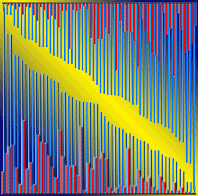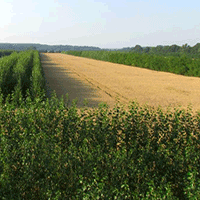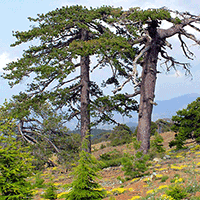Invasive alien tree species can strongly impact biodiversity and future projections predict their spread over natural, semi-natural and human habitats. However, little is known about plant communities that form during the first stages of invasion. We investigated the composition of plant communities in alien Robinia pseudoacacia L. secondary forests growing on grasslands and cultivated areas abandoned during the last 35-40 years in north-eastern Italy to understand whether these formations could cause floristic homogenization of plant communities composition. On the basis of a cluster analysis, plant communities were assigned to seven syntaxonomic categories and split into four groups characterized by the occurrence of 20 species indicative of (a) nitrogen-rich, (b) true forest and (c) open habitat conditions. RDA analysis enabled main stand and environmental variables filtering these communities to be identified and β-diversity components were partitioned through the SDR (Similarity - richness Difference - species Replacement) simplex approach. Plant composition patterns were significantly associated to variability in elevation, stand vertical structure, shrub cover, mean tree diameter and height, and basal area. Shrub cover discriminates between plant communities associated with open or shaded conditions. The partition of β-diversity components revealed that replacement is the prominent process structuring plant communities in these secondary forests. Our study showed that secondary Robinia forests growing on abandoned lands may host compositionally heterogeneous plant communities, thus contributing to regional biodiversity.
Keywords
, , , ,
Citation
Campagnaro T, Nascimbene J, Tasinazzo S, Trentanovi G, Sitzia T (2018). Exploring patterns, drivers and structure of plant community composition in alien Robinia pseudoacacia secondary woodlands. iForest 11: 586-593. - doi: 10.3832/ifor2687-011
Academic Editor
Matteo Garbarino
Paper history
Received: Nov 15, 2017
Accepted: Jun 26, 2018
First online: Sep 25, 2018
Publication Date: Oct 31, 2018
Publication Time: 3.03 months
© SISEF - The Italian Society of Silviculture and Forest Ecology 2018
Open Access
This article is distributed under the terms of the Creative Commons Attribution-Non Commercial 4.0 International (https://creativecommons.org/licenses/by-nc/4.0/), which permits unrestricted use, distribution, and reproduction in any medium, provided you give appropriate credit to the original author(s) and the source, provide a link to the Creative Commons license, and indicate if changes were made.

Breakdown by View Type
(Waiting for server response...)
Article Usage
Total Article Views: 47495
(from publication date up to now)
Breakdown by View Type
HTML Page Views: 40123
Abstract Page Views: 3063
PDF Downloads: 3233
Citation/Reference Downloads: 6
XML Downloads: 1070
Web Metrics
Days since publication: 2636
Overall contacts: 47495
Avg. contacts per week: 126.12
Article Citations
Article citations are based on data periodically collected from the Clarivate Web of Science web site
(last update: Mar 2025)
Total number of cites (since 2018): 14
Average cites per year: 1.75
Publication Metrics
by Dimensions ©
Articles citing this article
List of the papers citing this article based on CrossRef Cited-by.
(1)
ARPAV (2011)Il clima in Veneto [The climate in Veneto]. Web site. [in Italian]
Online |
Gscholar
(2)
Baselga A (2010)Partitioning the turnover and nestedness components of beta diversity. Global Ecology and Biogeography 19: 134-143.
CrossRef |
Gscholar
(3)
Benesperi R, Giuliani C, Zanetti S, Gennai M, Mariotti Lippi M, Guidi T, Nascimbene J, Foggi B (2012)Forest plant diversity is threatened by
Robinia pseudoacacia (black-locust) invasion. Biodiversity and Conservation 21: 3555-3568.
CrossRef |
Gscholar
(4)
Biondi E, Blasi C, Allegrezza M, Anzelotti I, Azzella MM, Carli E, Casavecchia S, Copiz R, Del Vico E, Facioni L, Galdenzi L, Gasparri R, Lasen C, Pesaresi S, Poldini L, Sburlino G, Vagge I, Zivkovic L (2015)Prodromo della vegetazione d’Italia [Prodrome of the Italian vegetation]. Web site. [in Italian]
Online |
Gscholar
(5)
Callaway RM, Brooker RW, Choler P, Kikvidze Z, Lortie CJ, Michalet R, Paolini L, Pugnaire FI, Newingham B, Aschehoug ET, Armas C, Kikodze D, Cook BJ (2002)Positive interactions among alpine plants increase with stress. Nature 417: 844-848.
CrossRef |
Gscholar
(6)
Camenen E, Porté AJ, Benito Garzón M (2016)American trees shift their niches when invading Western Europe: evaluating invasion risks in a changing climate. Ecology and Evolution 6: 7263-7275.
CrossRef |
Gscholar
(7)
Campagnaro T, Brundu G, Sitzia T (2018)Five major invasive alien tree species in European Union forest habitat types of the Alpine and Continental biogeographical regions. Journal for Nature Conservation 43: 227-238.
CrossRef |
Gscholar
(8)
Chang C-R, Lee PF, Bai ML, Lin TT (2004)Predicting the geographical distribution of plant communities in complex terrain - a case study in Fushian Experimental Forest, northeastern Taiwan. Ecography 27: 577-588.
CrossRef |
Gscholar
(9)
Chytry M, Pyšek P, Wild J, Pino J, Maskell LC, Vilà M (2009)European map of alien plant invasions based on the quantitative assessment across habitats. Diversity and Distributions 15: 98-107.
CrossRef |
Gscholar
(10)
Cierjacks A, Kowarik I, Joshi J, Hempel S, Ristow M, Von Der Lippe M, Weber E (2013)Biological flora of the British Isles:
Robinia pseudoacacia. Journal of Ecology 101: 1623-1640.
CrossRef |
Gscholar
(11)
De Caceres M, Legendre P, Moretti M (2010)Improving indicator species analysis by combining groups of sites. Oikos 119: 1674-1684.
CrossRef |
Gscholar
(12)
Del Favero R (2006)Carta Regionale dei tipi forestali: documento base [Regional map of forest types: support document]. Regione del Veneto, Direzione regionale delle foreste e dell’economia montana, Accademia Italiana di Scienze Forestali, Mestre-Venezia, Italy, pp. 90. [in Italian]
Gscholar
(13)
Dufrêne M, Legendre P (1997)Species assemblages and indicator species: the need for flexible assymetrical approach. Ecological Monographs 67: 345-366.
CrossRef |
Gscholar
(14)
Essl F, Milasowszky N, Dirnböck T (2011)Plant invasions in temperate forests: resistance or ephemeral phenomenon? Basic and Applied Ecology 12: 1-9.
CrossRef |
Gscholar
(15)
Fugère V, Kasangaki A, Chapman LJ (2016)Land use changes in an afrotropical biodiversity hotspot affect stream alpha and beta diversity. Ecosphere 7: e01355.
CrossRef |
Gscholar
(16)
Keenleyside C, Tucker GM (2010)Farmland abandonment in the EU: an assessment of trends and prospects. Institute for European Environmental Policy, London, UK, pp. 93.
Online |
Gscholar
(17)
Kleinbauer I, Dullinger S, Peterseil J, Essl F (2010)Climate change might drive the invasive tree
Robinia pseudacacia into nature reserves and endangered habitats. Biological Conservation 143: 382-390.
CrossRef |
Gscholar
(18)
Kowarik I (2011)Novel urban ecosystems, biodiversity, and conservation. Environmental Pollution 159: 1974-1983.
CrossRef |
Gscholar
(19)
Lambdon PW, Pyšek P, Basnou C, Hejda M, Arianoutsou M, Essl F, Jarošík V, Pergl J, Winter M, Anastasiu P, Andriopoulos P, Bazos I, Brundu G, Celesti-Grapow L, Chassot P, Delipetrou P, Josefsson M, Kark S, Klotz S, Kokkoris Y, Kühn I, Marchante H, Perglová I, Pino J, Vilà M, Zikos A, Roy D, Hulme PE (2008)Alien flora of Europe: species diversity, temporal trends, geographical patterns and research needs. Preslia 80: 101-149.
Online |
Gscholar
(20)
Laurance WF, Nascimento HEM, Laurance SG, Andrade A, Ewers RM, Harms KE, Luizão RCC, Ribeiro JE (2007)Habitat fragmentation, variable edge effects, and the landscape-divergence hypothesis. PLoS ONE 2: e1017.
CrossRef |
Gscholar
(21)
Legendre P (2014)Interpreting the replacement and richness difference components of beta diversity. Global Ecology and Biogeography 23: 1324-1334.
CrossRef |
Gscholar
(22)
Legendre P, Gallagher ED (2001)Ecologically meaningful transformations for ordination of species data. Oecologia 129: 271-280.
CrossRef |
Gscholar
(23)
MacDougall AS, Turkington R (2005)Are invasive species the drivers or passengers of change in degraded ecosystems? Ecology 86: 42-55.
CrossRef |
Gscholar
(24)
Marini L, Bertolli A, Bona E, Federici G, Martini F, Prosser F, Bommarco R (2013)Beta-diversity patterns elucidate mechanisms of alien plant invasion in mountains. Global Ecology and Biogeography 22: 450-460.
CrossRef |
Gscholar
(25)
Melbourne BA, Cornell HV, Davies KF, Dugaw CJ, Elmendorf S, Freestone AL, Hall RJ, Harrison S, Hastings A, Holland M, Holyoak M, Lambrinos J, Moore K, Yokomizo H (2007)Invasion in a heterogeneous world: resistance, coexistence or hostile takeover? Ecology Letters 10: 77-94.
CrossRef |
Gscholar
(26)
Oksanen J, Blanchet FG, Kindt R, Legendre P, Minchin PR, O’Hara RB, Simpson GL, Solymos P, Stevens MHH, Wagner H (2015)vegan: community ecology package. R package version 2.3-1.
Online |
Gscholar
(27)
Podani J (2001)Syn-Tax 2000. Computer program for data analysis in ecology and systematics. User’s manual. Scientia Publishing, Budapest, Hungary, pp. 452.
Gscholar
(28)
Podani J, Ricotta C, Schmera D (2013)A general framework for analyzing beta diversity, nestedness and related community-level phenomena based on abundance data. Ecological Complexity 15: 52-61.
CrossRef |
Gscholar
(29)
Podani J, Schmera D (2011)A new conceptual and methodological framework for exploring and explaining pattern in presence - absence data. Oikos 120: 1625-1638.
CrossRef |
Gscholar
(30)
Pyšek P, Chytry M, Pergl J, Sádlo J, Wild J (2012)Plant invasions in the Czech Republic: current state, introduction dynamics, invasive species and invaded habitats. Preslia 84: 575-629.
Gscholar
(31)
Quantum GIS Development Team (2012)Quantum GIS geographic information system. Open source geospatial foundation project, Web site.
Online |
Gscholar
(32)
R Development Core Team (2015)R: a language and environment for statistical computing. R Foundation for Statistical Computing, Vienna, Austria.
Online |
Gscholar
(33)
Rehounková K, Prach K (2008)Spontaneous vegetation succession in gravel-sand pits: a potential for restoration. Restoration Ecology 16: 305-312.
CrossRef |
Gscholar
(34)
Rejmánek M, Richardson DM (2013)Trees and shrubs as invasive alien species - 2013 update of the global database. Diversity and Distributions 19: 1093-1094.
CrossRef |
Gscholar
(35)
Richardson DM (1998)Forestry trees as invasive aliens. Conservation Biology 12: 18-26.
CrossRef |
Gscholar
(36)
Sitzia T, Semenzato P, Trentanovi G (2010)Natural reforestation is changing spatial patterns of rural mountain and hill landscapes: a global overview. Forest Ecology and Management 259: 1354-1362.
CrossRef |
Gscholar
(37)
Sitzia T, Campagnaro T, Dainese M, Cierjacks A (2012)Plant species diversity in alien black locust stands: a paired comparison with native stands across a north-Mediterranean range expansion. Forest Ecology and Management 285: 85-91.
CrossRef |
Gscholar
(38)
Sitzia T, Cierjacks A, De Rigo D, Caudullo G (2016a)Robinia pseudoacacia in Europe: distribution, habitat, usage and threats. In: “European Atlas of Forest Tree Species” (San-Miguel-Ayanz J, De Rigo D, Caudullo G, Houston Durrant T, Mauri A eds). Publication Office of the European Union, Luxembourg, pp. 166-167.
Online |
Gscholar
(39)
Sitzia T, Campagnaro T, Weir RG (2016b)Novel woodland patches in a small historical Mediterranean city: Padova, Northern Italy. Urban Ecosystems 19: 475-487.
CrossRef |
Gscholar
(40)
Sitzia T, Campagnaro T, Kowarik I, Trentanovi G (2016c)Using forest management to control invasive alien species: helping implement the new European regulation on invasive alien species. Biological Invasions 18: 1-7.
CrossRef |
Gscholar
(41)
Sitzia T, Campagnaro T, Kotze DJ, Nardi S, Ertani A (2018)The invasion of abandoned fields by a major alien tree filters understory plant traits in novel forest ecosystems. Scientific Reports 8: 8410.
CrossRef |
Gscholar
(42)
Socolar JB, Gilroy JJ, Kunin WE, Edwards DP (2016)How should beta-diversity inform biodiversity conservation? Trends in Ecology and Evolution 31: 67-80.
CrossRef |
Gscholar
(43)
Solar RRDC, Barlow J, Ferreira J, Berenguer E, Lees AC, Thomson JR, Louzada J, Maués M, Moura NG, Oliveira VHF, Chaul JCM, Schoereder JH, Vieira ICG, Mac Nally R, Gardner TA (2015)How pervasive is biotic homogenization in human-modified tropical forest landscapes? Ecology Letters 18: 1108-1118.
CrossRef |
Gscholar
(44)
Terwei A, Zerbe S, Mölder I, Annighöfer P, Kawaletz H, Ammer C (2016)Response of floodplain understorey species to environmental gradients and tree invasion: a functional trait perspective. Biological Invasions 18: 2951-2973.
CrossRef |
Gscholar
(45)
Trentanovi G, Von Der Lippe M, Sitzia T, Ziechmann U, Kowarik I, Cierjacks A (2013)Biotic homogenization at the community scale: disentangling the roles of urbanization and plant invasion. Diversity and Distributions 19: 738-748.
CrossRef |
Gscholar
(46)
Van Der Maarel E (1979)Transformation of cover-abundance values in phytosociology and its effect on community similarity. Vegetatio 39: 97-114.
CrossRef |
Gscholar
(47)
Vítková M, Kolbek J (2010)Vegetation classification and synecology of Bohemian
Robinia pseudacacia stands in a Central European context. Phytocoenologia 40: 205-241.
CrossRef |
Gscholar
(48)
Vítková M, Müllerová J, Sádlo J, Pergl J, Pyšek P (2017)Black locust (
Robinia pseudoacacia) beloved and despised: a story of an invasive tree in Central Europe. Forest Ecology and Management 384: 287-302.
CrossRef |
Gscholar
(49)
Vítková M, Tonika J, Müllerová J (2015)Black locustâsuccessful invader of a wide range of soil conditions. Science of The Total Environment 505: 315-328.
CrossRef |
Gscholar
(50)
Whittaker RH (1960)Vegetation of the Siskiyou Mountains, Oregon and California. Ecological Monographs 30: 279-338.
CrossRef |
Gscholar


















